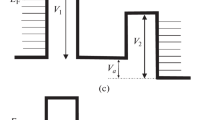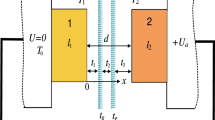Abstract
A critical examination is presented of the vacuum-nanotriode experiment by Driskill-Smith et al. [1]. It is shown that the quantum electron device cannot be validly described with respect to a single coordinate but rather must be modeled in three dimensions. Such a model is constructed and validated using the semiclassical approximation and concepts of electron optics. It is demonstrated within this framework that the transconductance oscillations observed in the vacuum nanotriode are caused by the quantum interference of three mutually coherent electron waves within the gate aperture, the waves being produced by the field-emission tips of the cathode. It is noted that quantum-interference transconductance oscillations can occur only if the amplitude and phase of each of the three electron waves on the gate aperture, as well as electron-wave vignetting, are dependent on the gate potential.
Similar content being viewed by others
REFERENCES
Driskill-Smith, A.A.G., Hasko, D.G., and Ahmed, H., Quantum Interference in a Vacuum Nanotriode, J. Vac. Sci. Technol., B, 2000, vol. 18, no.6, pp. 3481–3487.
Valiev, K.A., Fizika submikronnoi litografii (Physics of Submicrometer Lithography), Moscow: Nauka, 1990.
Goulet, T. and Jay-Gerin, J.-P., Radiat. Phys. Chem., 1986, vol. 27, no.3, pp. 229–239.
Zhukov, V.A., Model of Quantum Interferometer in Vacuum Nanotriode and Quantum Bit Realization, in Proc. SPIE—Int. Soc. Opt. Eng., 2003, vol. 5128, pp. 175–181.
Landau, L.D. and Lifshits, E.M., Quantum Mechanics, Moscow: Fizmatgiz, 1963.
Fowler, R.H. and Nordheim, L., Electron Emission in Intense Electric Fields, Proc. R. Soc. London, Ser. A, 1928, vol. 119, no.781, p. 173.
Heidenreich, R.D., Fundamentals of Transmission Electron Microscopy, New York: Interscience, 1964.
Kittel, C., Elementary Solid State Physics, New York: Wiley, 1962.
Szilagyi, M., Electron and Ion Optics, New York: Plenum, 1988.
Glaser, W., Grundlagen der Elektronenoptik, Wien: Springer, 1952.
Author information
Authors and Affiliations
Additional information
Translated from Mikroelektronika, Vol. 34, No. 2, 2005, pp. 129–137.
Original Russian Text Copyright © 2005 by Zhukov.
Rights and permissions
About this article
Cite this article
Zhukov, V.A. Theory of the vacuum nanotriode, part 1: Explaining the results of an experiment. Russ Microelectron 34, 103–110 (2005). https://doi.org/10.1007/s11180-005-0013-8
Received:
Issue Date:
DOI: https://doi.org/10.1007/s11180-005-0013-8




